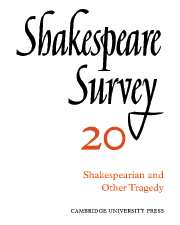Book contents
- Frontmatter
- Shakespeare, Fletcher and Baroque Tragedy
- Seneca and the Elizabethans: A Case-study in ‘Influence’
- George Chapman: Tragedy and the Providential View of History
- Critical Disagreement about Oedipus and Hamlet
- Shakespeare’s Thematic Modes of Speech: ‘Richard II’ to ‘Henry V’
- Anarchy and Order in ‘Richard III’ and ‘King John’
- The Staging of Parody and Parallels in ‘I Henry IV’
- Shakespeare’s Unnecessary Characters
- Walter Whiter’s Notes on Shakespeare
- Shakespeare’s ‘Romeo and Juliet’: Its Spanish Source
- The Grieves Shakespearian Scene Designs
- Shakespeare on the Modern Stage: Past Significance and Present Meaning
- Shakespeare in Brazil
- Recent Shakespeare Performances in Romania
- Shakespeare, the Twentieth Century and ‘Behaviourism’
- The Year's Contributions to Shakespearian Study 1 Critical Studies
- 2 Shakespeare’s Life, Times and Stage
- 3 Textual Studies
- Index
- Plate section
Shakespeare’s Thematic Modes of Speech: ‘Richard II’ to ‘Henry V’
Published online by Cambridge University Press: 28 March 2007
- Frontmatter
- Shakespeare, Fletcher and Baroque Tragedy
- Seneca and the Elizabethans: A Case-study in ‘Influence’
- George Chapman: Tragedy and the Providential View of History
- Critical Disagreement about Oedipus and Hamlet
- Shakespeare’s Thematic Modes of Speech: ‘Richard II’ to ‘Henry V’
- Anarchy and Order in ‘Richard III’ and ‘King John’
- The Staging of Parody and Parallels in ‘I Henry IV’
- Shakespeare’s Unnecessary Characters
- Walter Whiter’s Notes on Shakespeare
- Shakespeare’s ‘Romeo and Juliet’: Its Spanish Source
- The Grieves Shakespearian Scene Designs
- Shakespeare on the Modern Stage: Past Significance and Present Meaning
- Shakespeare in Brazil
- Recent Shakespeare Performances in Romania
- Shakespeare, the Twentieth Century and ‘Behaviourism’
- The Year's Contributions to Shakespearian Study 1 Critical Studies
- 2 Shakespeare’s Life, Times and Stage
- 3 Textual Studies
- Index
- Plate section
Summary
Just as Shakespeare’s characters in a given play tend to use the same words and images, they also tend to use the same ‘modes’ of speech. For instance, Hamlet, one of the few plays in which this characteristic has been noted, is full of questions. Not all of its speeches take the form of questions, of course, or even most of them; nor is questioning the play’s only recurring mode of speech, may of the characters being equally inclined toward lengthy admonition. Yet the ‘interrogative mood’ the questions create does make a contribution of thematic importance to the tone and meaning of the play. The same can be said, I believe, of comparable modes of speech in many—perhaps all—of Shakespeare’s plays. As a start toward testing this belief, I should like to look at Richard II, 1 Henry IV, 2 Henry IV, and Henry V.
The central mode of speech in Richard II is that of denunciation. Of the four plays, this is the only one which draws its modes to a large extent from its sources. For the most part, Shakespeare intensifies the denunciations he finds in Hall and Holinshed. Where, for instance, in Holinshed York simply 'delivered the indenture' to the king which exposed his son's plot, in the play he inveighs repeatedly against the 'villain' and 'traitor' (v, ii and iii). Only the formal accusations and grievous crimes that Northumberland tries to make Richard read at his deposition (iv, i, 223-7) receive less emphasis in the play than in the Chronicles.
- Type
- Chapter
- Information
- Shakespeare Survey , pp. 41 - 50Publisher: Cambridge University PressPrint publication year: 1967
- 1
- Cited by

